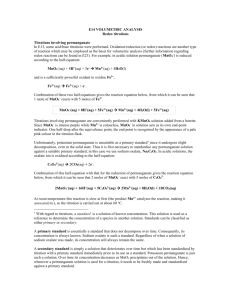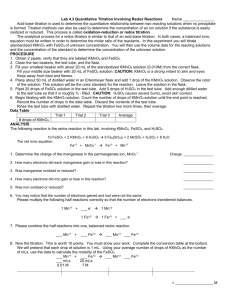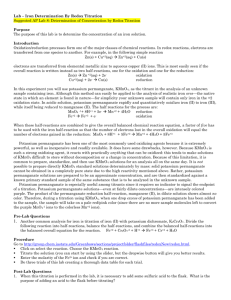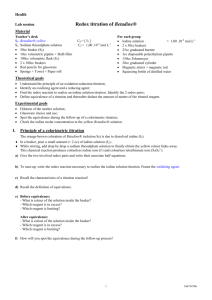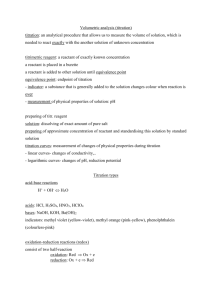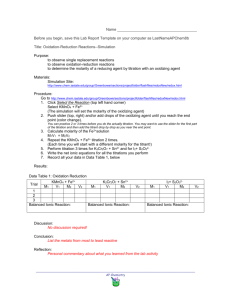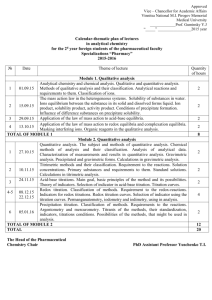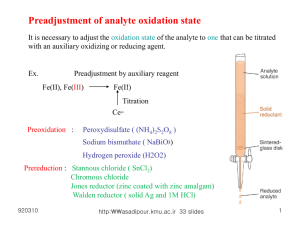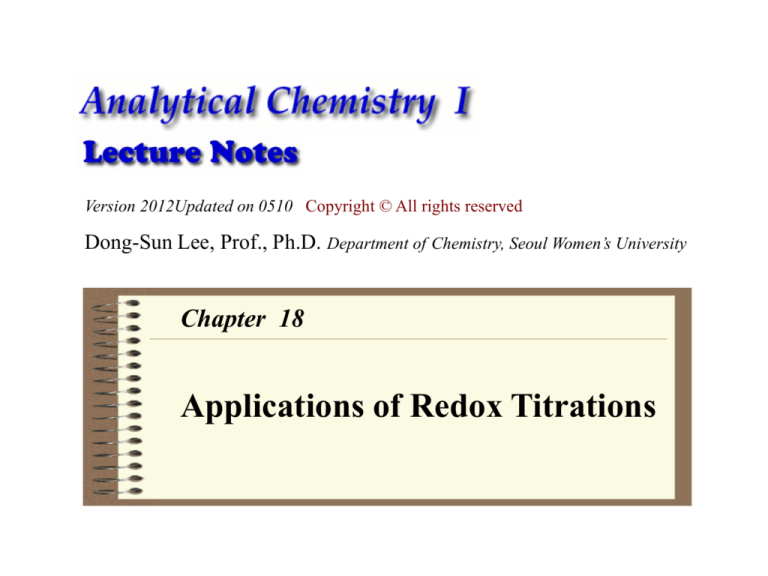
Version 2012Updated on 0510 Copyright © All rights reserved
Dong-Sun Lee, Prof., Ph.D. Department of Chemistry, Seoul Women’s University
Chapter 18
Applications of Redox Titrations
Linus Pauling (1901-1994)
His work in chemical bonding, X-ray
crystallography, and related areas had a
tremendous impact on chemistry, physics,
and biology. He is the only person to
receive two unshared Nobel prizes: for
chemistry(1954) and for his efforts to ban
nuclear weapons, the peace prize (1962).
This photo of Pauling tossing an orange
into the air is symbolic of his work and
importance of being able to determine
concentrations of ascorbic acid at all
levels in fruits and commercial vitamin
preparations. Redox titrations with iodine
are widely used to determine ascorbic
acid.
Preadjustment of analyte oxidation state
It is necessary to adjust the oxidation state of the analyte to one that can be titrated
with an auxiliary oxidizing or reducing agent.
Ex.
Preadjustment by auxiliary reagent
Fe(II), Fe(III)
–
4
Fe(II)
Titration
Ce4+
Preoxidation :
2–
Peroxydisulfate ( (NH4)2S)2O8 )
Sodium bismuthate ( NaBiO3)
Hydrogen peroxide (H 2O2)
Prereduction : Stannous chloride ( SnCl 2 )
Chromous chloride
Jones reductor (zinc coated with zinc amalgam)
Walden reductor ( solid Ag and 1M HCl)
Jones reductor :
2Zn (s) + Hg2+ Zn2+ + Zn(Hg) (s)
Reagents used in redox titration
Reducing agents
Ferrous salts :
ammonium iron(II) sulfate hexahydrate (Mohr’s salt)
FeSO4(NH4)2SO4· 6H2O
iron(II) ethylene diamine sulfate (Oesper’s salt) FeC2H4(NH3)2(SO4)2· 4H2O
Sodium thiosulfate pentahydrate
Na2S2O3·5H2O
Arsenic trioxide: arsenious oxide
As2O3
Sodium oxalate and oxalic acid dihydarte Na2(COO)2 ,
Titanium trichloride
Potassium ferrocyanide
TiCl3
K4Fe(CN)6 · 3H2O
(COOH)2·2H2O
Sodium thiosulfate, Na2S2O3
Thiosulfate ion is a moderately strong reducing agent that has been widely
used to determine oxidizing agents by an indirect procedure that involves
iodine as an intermediate. With iodine, thiosulfate ion is oxidized quantitatively
to tetrathionate ion according to the half-reaction:
2S2O3 2– S4O6 2– + 2e
Eo = 0.08
Ex. Determination of hypochlorite in bleaches [CaCl(OCl)H2O]:
OCl– + 2I– + 2H+ Cl– + I2 + H2O (unmeasured excess KI)
I2 + 2 S2O3 2– 2I– + S4O6 2–
Indicator: soluble starch (-amylose)
Standardization of thiosulfate solution:
Primary standard : potassium iodate (KIO3), K2Cr2O7, KBrO3
Titration reactions:
KIO3 + 5KI + 6HCl 3I2 + 6KCl + 3 H2O
I2 + 2Na2S2O3 2NaI + Na2S4O6
KIO3
3I2
6Na2S2O3·5H2O
mw 214.02
6 Equivalent
248.21
214.02 g
6 × 248.21g
214.02 g / 6
1 N × 1000 ml
35.67 g
1 N × 1000 ml
ag
x N × V ml
x N = ( a g × 1 N × 1000 ml) / (35.67 g × V ml)
Stabilizer for sodium thiosulfate solution : Na2CO3
Na2S2O3 + H2O + CO2 Na2CO3 + H2S2O3
H2S2O3 H2SO3 + S
Calculations
Equivalent weight = ( formula weight) / ( e– change)
Equivalents = g / eq. wt.
meq = mg / eq. Wt.
Normality (N) = eq / L = meq / ml
Reaction
eq. wt of reactant
Fe2+ Fe3+ + e
FW Fe ÷ 1
KMnO4 + 5e Mn2+
FW KMnO4 ÷ 5
Na2S2O35H2O ½ S4O6– + e
FW Na2S2O35H2O ÷ 1
Cr2O72 – + 6e 2 Cr3+
FW Cr2O72 – ÷ 6
Molecular model of thiosulfate ion.
Structure of the repeating unit of the sugar
amylose.
Schematic structure of the starch-iodine
complex. The amylose chain forms a
helix around I6 unit.
View down the starch helix, showing
iodine, inside the helix
Arsenious oxide, As4O6
As4O6 + 6H2O = 4H3AsO3
H3AsO3 + I3– + H2O = H3AsO4 + 3I– + 2H+
The As4O6 molecule consists of
an As4 tetrahedron with a bridging
oxygen atom on each edge
Reagents used in redox titration
Oxidizing agents
Potassium permanganate KMnO4
:
Permanganometry
Ceric sulfate / Ceric ammonium sulfate
Cerimetry
Potassium dichromate K2Cr2O7
Iodine I2 :
:
Ce(SO4)2·2(NH4)2SO4· 4H2O :
Dichrometry
Iodimetry, Iodometry
Potassium iodate
KIO3
:
Iodatimetry
Potassium bromate KBrO3 : Bromatimetry
Sodium nitrite NaNO2 :
Calcium hypochlorite Ca(ClO)2 :
Permanganate titration
Oxidation with permanganate : Reduction of permanaganate
KMnO4 Powerful oxidant that the most widely used.
In strongly acidic solutions (1M H2SO4 or HCl, pH 1)
MnO4– + 8H+ + 5e = Mn2 + + 4H2 O
violet color
Eo = 1.51 V
colorless manganous
KMnO4 is a self-indicator.
In feebly acidic, neutral, or alkaline solutions
MnO4– + 4H+ + 3e = MnO2 (s) + 2H2 O
Eo = 1.695 V
brown manganese dioxide solid
In very strongly alkaline solution (2M NaOH)
MnO4– + e = MnO42 –
green manganate
Eo = 0.558 V
Standardization of KMnO4 solution
Potassium permanganate is not primary standard, because traces of MnO2
are invariably present.
Standardization by titration of sodium oxalate (primary standard) :
2KMnO4 + 5 Na2(COO)2 + 8H2SO4 = 2MnSO4 + K2SO4 + 5Na2SO4 + 10 CO2 + 8H2O
2KMnO4
mw 158.03
158.03 g / 5
31.606 g
1N × 1000 ml
x N × V ml
5 Na2(COO)2
mw 134.01
134.01 g / 2
10 Equivalent
1 Eq.
67.005 g
67.005 g
ag
x N = ( a g × 1N × 1000 ml) / (67.005 g × V ml)
Preparation of 0.1 N potassium permanganate solution
KMnO4 is not pure. Distilled water contains traces of organic reducing substances which
react slowly with permanganate to form hydrous managnese dioxide. Manganesse dioxide
promotes the autodecomposition of permanganate.
1)
Dissolve about 3.2 g of KMnO4 (mw=158.04) in 1000ml of water,
heat the solution to boiling, and keep slightly below the boiling point for 1 hr.
Alternatively , allow the solution to stand at room temperature for 2 or 3 days.
2)
Filter the liquid through a sintered-glass filter crucible to remove solid MnO2.
3)
Transfer the filtrate to a clean stoppered bottle freed from grease with cleaning
mixture.
4)
Protect the solution from evaporation, dust, and reducing vapors, and keep it in the
dark or in diffuse light.
5)
If in time managanese dioxide settles out, refilter the solution and restandardize it.
Applications of permanganometry
(1) H2O2
2KMnO4 + 5 H2O2 + 3H2SO4 = 2MnSO4 + K2SO4 + 5O2 + 8H2O
(2) NaNO2
2NaNO2 + H2SO4 =
Na2SO4 + HNO2
2KMnO4 + 5 HNO2 + 3H2SO4 = 2MnSO4 + K2SO4 + 5HNO3 + 3H2O
(3) FeSO4
2KMnO4 + 510 FeSO4 + 8H2SO4 = 2MnSO4 + K2SO4 + 5Fe2(SO4)3 + 8H2O
(4) CaO
CaO + 2HCl = CaCl2 + H2O
CaCl2 + H2C2O4 = CaC2O4 + 2HCl
(excess oxalic acid)
2KMnO4 + 5 H2C2O4 + 3H2SO4 = 2MnSO4 + K2SO4 + 10CO2 + 8H2O (back tit)
(5) Calcium gluconate
[CH2OH(CHOH)4COO]2Ca + 2HCl = CaCl + 2CH2OH9CHOH)4COOH
(NH4)2C2O4 + CaCl2 = CaC2O4 + 2 NH4Cl
CaCl2
+ H2SO4 = H2C2O4 + CaSO4
2KMnO4 + 5 H2C2O4 + 3H2SO4 = 2MnSO4 + K2SO4 + 10CO2 + 8H2O
Oxidation with Ce4+
Ce4+ + e = Ce3+
1.7 V in 1 N HClO4
yellow
1.61 V in 1N HNO3
colorless
1.47 V in 1N HCl
1.44 V in 1M HSO4
Indicator : ferroin, diphenylamine
Preparation and standardization:
Ammonium hexanitratocerate, (NH4)2Ce(NO3)6, (primary standard grade)
Ce(HSO4)4,
Standardized with Sodium oxalate.
(NH4)4Ce(SO4)4·2H2O
Applications of cerimetry
(1) Menadione (2-methylnaphthoquinon: vitamin K3)
HCl, Zn
O
CH3
O
OH
CH3
Reduction
2 Ce(SO4)2
OH
(2) Iron
2FeSO4 + 2 (NH4)4Ce(SO4)4 = Fe2(SO4)3 + Ce2(SO4)3 + 4 (NH4)2SO4
Oxidation with potassium dichromate
Cr2O72– + 14H+ + 6e = 2Cr3+ + 7H2O
K2Cr2O7 is a primary standard.
Indicator : diphenylamine sulphonic acid
Eo = 1.36 V
Ex. Redox titration ( hydroquinone vs dichromate standard solution )
Cr2O72– + 14H+ + 6e
3
HO
3 HO
OH
2 Cr3+ + 7 H2O
Eo= 1.33
O
OH + Cr2O72– + 8H+
O
+ 2H+ + 2e
Eo= 0.700
O + 2 Cr3+ + 7 H2O
3O
Eo= Eocathode – Eoanode = 1.33 – 0.700 = 0.63 V
K = 10 nEo/0.05916 = 10 6(0.63) / 0.05916 = 10 64
redox indicator : diphenylamine
colorless to violet
Very large : quantitative : complete reaction
Iodimetry and iodometry
Iodimetry : a reducing analyte is titrated directly with iodine.
Iodometry : an oxidizing analyte is added to excess iodide to produce iodine,
which is then titrated with standard thiosulfate solution.
Its solubility is enhanced by complexation with iodide.
I2 + I– = I3–
K = 7 102
Bromatimetry
KBrO3
BrO3– + 5Br– + 6H+ 3Br2 + H2O
2I– + Br2 I2 + 2Br–
I2 + 2 S2O32– 2I– + 2S4O62–
Substitution reactions
BrO3– + 5Br– + 6H+ 3Br2 + H2O
2I– + Br2 I2 + 2Br–
I2 + 2 S2O32– 2I– + S4O62–
pH 4-9
Al3+ + 3HOC9H6N Al(OC9H6N)3 (s) + 3H+
hot 4M HCl
Al(OC9H6N)3 (s) 3HOC9H6N + Al3+
3HOC9H6N + 6 Br2 3HOC9H4NBr2 + 6HBr
1 mol Al3+ 3 mol HOC9H6N 6 mol Br2 2 mol KBrO3
Addition reactions
Determining water with the Karl Fisher Reagent
The Karl Fisher reaction :
I2 + SO2 + 2H2O 2HI + H2SO4
For the determination of small amount of water, Karl Fischer(1935) proposed a
reagent prepared as an anhydrous methanolic solution containing iodine, sulfur
dioxide and anhydrous pyridine in the mole ratio 1:3:10. The reaction with water
involves the following reactions :
C5H5N•I2 + C5H5N•SO2 + C5H5N + H2O 2 C5H5N•HI + C5H5N•SO3
C5H5N+•SO3– + CH3OH C5H5N(H)SO4CH3
Pyridinium sulfite can also consume water.
C5H5N+•SO3– + H2O C5H5NH+SO4H–
It is always advisable to use fresh reagent because of the presence of various side
reactions involving iodine. The reagent is stored in a desiccant-protected container.
The end point can be detected either by visual( at the end point, the color changes
from dark brown to yellow) or electrometric, or photometric (absorbance at 700nm)
titration methods. The detection of water by the coulometric technique with Karl
Fischer reagent is popular.
Pyridine free Karl Fisher reagent
In recent years, pyridine, and its objectionable odor, have been replaced in the Karl
Fisher reagent by other amines, particularly imidazole.
(1) Solvolysis
2ROH + SO2 RSO3–
(2) Buffering
B + RSO3– + ROH2+ BH+SO3R– + ROH
(3) Redox
B•I2
+ ROH2+
+ BH+SO3R– + B + H2O BH+SO4R– + 2 BH+I–
Summary
Preoxidation
Redox indicator
Oxidizing agent
Iodine starch indicator
Reducing agent
Self indicator
Redox titration
Karl Fisher titration
Permanganometry
Karl Fisher reagent
Cerimetry
Dichrometry
Iodimetry
Iodometry
Iodatimetry
Bromatimetry
終講
dslee@swu.ac.kr
http://mail.swu.ac.kr/~cat

